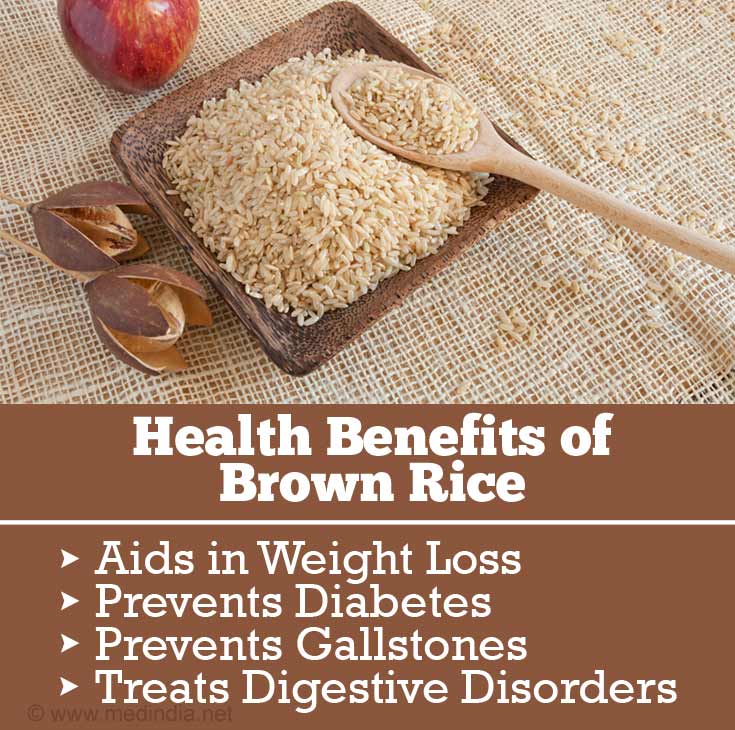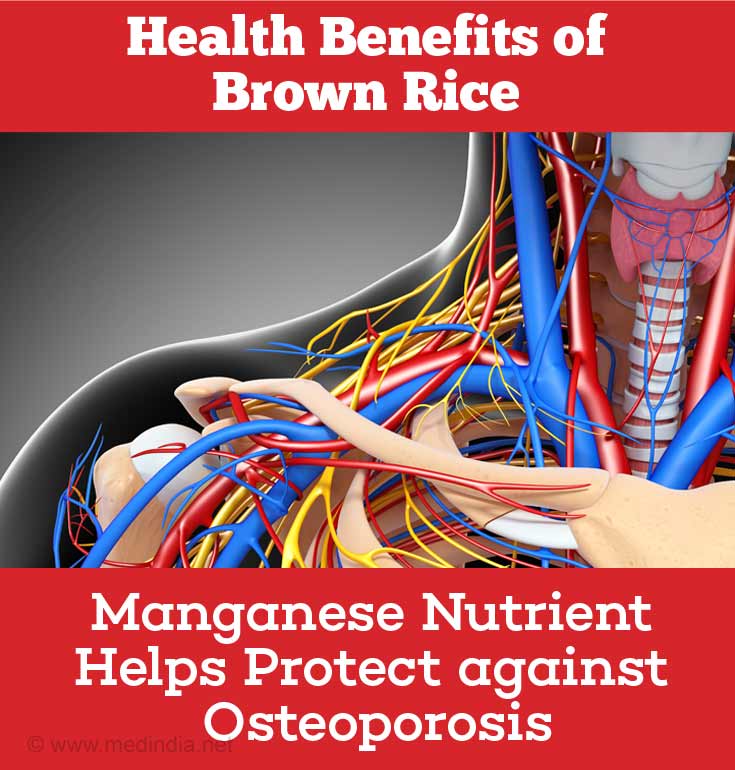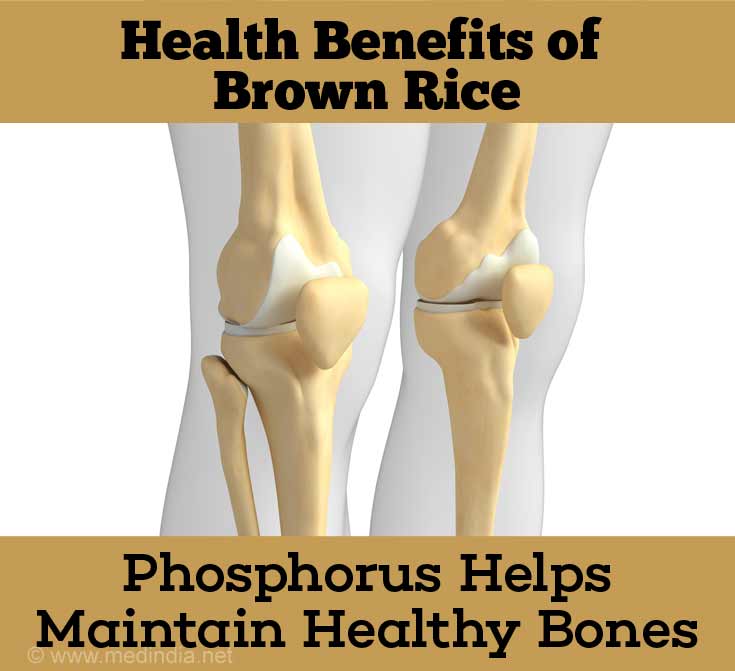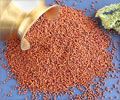- Brown Rice - Wikipedia - (https://en.wikipedia.org/wiki/Brown_rice)
- Nutrition and healthy eating - (http://www.mayoclinic.org/healthy-lifestyle/nutrition-and-healthy-eating/in-depth/whole-grains/art-20047826)
- About Brown Rice - (http://www.whfoods.org/genpage.php?tname=foodspice&dbid=128)
What is Brown Rice?
As strange as it may seem, most Indians are better acquainted with some foods in their processed and refined form. This is most true in the case of rice, as all of us are familiar with white rice, but have rarely come across brown rice.
Brown rice is actually whole grain rice and is also referred to as hulled or unmilled rice. Generally, this type of whole rice is processed through milling and polishing to increase shelf life and the resultant product is white rice. This is done, as brown rice tends to rancid a lot faster because of the presence of the bran and germ, which greatly increases its nutritional value. This basically means that the process that increases the life of rice and gives it the appearance that we are so familiar with also strips it of its nutritional value. Milling and polishing, which are the processes used to make white rice result in the destruction and loss of almost all vitamin B1, B3 and B6 content and half of all the manganese, phosphorus, iron, dietary fiber and other nutrients.

Brown rice isn’t just healthier than white rice, to a lot of folks it also tastes better. Brown rice has a mild nutty flavor and it is a lot chewier as compared to white rice. It doesn’t matter what variety of rice you prefer, from Basmati to Joha or Jasmine, they’re all originally brown rice and they are all healthiest as brown rice. Keep in mind that in recent years, there has been some concern about rice cultivation in certain parts of the world as the practices used, result in high arsenic levels.
What are the Health Benefits of Brown Rice?
In terms of caloric and carbohydrate value, there is little difference between brown and white rice, but if you dig deeper it becomes apparent that the health benefits of brown rice far outweigh any possible benefit from consuming white rice. Some noteworthy benefits of whole grain brown rice include:
- Dietary Fiber: Brown rice contains about five times the fiber content of white rice, because most of the dietary fiber is lost during milling and polishing. This particular nutritional feature is, in fact, responsible for a whole range of health benefits that include:
- Weight Loss: Brown rice is the perfect food for weight loss because it is low in calories and high in fiber, which means that it makes you feel full faster and keeps you satiated for a lot longer. Several studies have also shown that a high intake of dietary fiber from whole grains reduces the risk of weight gain by as much as 50 percent.
- Prevents Diabetes: The connection between brown rice and diabetes protection was also established in some studies and suggests that individuals with a substantial fiber intake of dietary fiber from whole grains may have greater protection against diabetes. Dietary fiber also helps regulate blood sugar levels.
- Bowel Function: Regular consumption of brown rice improves bowel movement and could also lower the risk of colon cancer and other digestive disorders.
- Prevents Gallstones: According to some studies, a diet rich in dietary fibers, both soluble and insoluble, also offers protection against gallstones! This effect is believed to be the outcome of reduced intestinal transit time, increased insulin sensitivity, reduction in bile secretion and lower triglyceride levels.
- Selenium: This is a trace mineral that has been found to offer some kind of protection against colon cancer. Selenium can actually inhibit the proliferation of cancer cells as it induces the repair of DNA and synthesis in damaged cells. This is acknowledged by researchers and the only question now, is ‘how does it do this?’ Incidentally, selenium doesn’t just help with cancer prevention, but also offers some protection from heart disease, rheumatoid arthritis and asthma.
- Manganese: This mineral is essential for the proper metabolism and synthesis of protein, carbohydrates and fatty acids, all of which are important to the health of the nervous system. Manganese is an essential nutrient that helps in bone formation and is also believed to help protect against osteoporosis and bone mass loss.


- Magnesium: This is an essential mineral, which means that it is no less important than any of the other essential nutrients although others like iron, calcium and potassium are better known. Dietary deficiencies in magnesium can contribute to the development of a variety of chronic diseases including lifestyle diseases like cardiovascular disease, hypertension, diabetes and osteoporosis. Brown rice is an important source of this nutrient as a large serving of rice (200 grams) will give you a fifth of your daily requirement of the mineral.
- Phosphorus: This is another essential nutrient that aids in proper cell functioning, regulation of calcium and the maintenance of healthy bones and teeth. Phosphorus plays a crucial role in various bodily functions, regulating the body’s utilization of fats and carbohydrates, the production and utilization of protein in growth, maintenance, and repair of cells and tissues. It is also essential for the production of adenosine triphosphate, which the body uses for energy storage.

Keep in mind that while all of these individual nutrients can be obtained through supplementation, most studies do not reveal similar protective effects as this may be because of the particular grouping and the natural occurrence of such nutrients in whole grains that exercises such beneficial effects.
Brown Rice Recipes
Brown Rice Khichdi
Ingredients:
- Brown Rice – 3/4th Cup
- Moong dhal – ½ cup
- Olive oil - ½ teaspoon
- Cumin seeds - ½ teaspoon
- Small onion, chopped - 1
- Curry leaves – 1 sprig
- Small tomatoes or puree – 2 or ¼ cup
- Sweet potato – ½ and diced fine
- Green peas – ½ cup
- Baby eggplants – 2 cut in cubes
- Turmeric – 1 pinch
- Coriander powder – ½ tablespoon
- Garam masala – ½ teaspoon
- Garlic – 2 cloves
- Lemon – 1
- Coriander & mint leaves – 1 Handful, finely chopped
- Salt
Preparation:
- Heat the olive oil in a pressure cooker and add the cumin seeds.
- As soon as the seeds begin to sizzle, add the onions and curry leaves.
- Keep stirring and as the onions start to brown, add the garlic.
- In about half a minute you can add the tomato puree, and the coriander and turmeric powders. Stir well and wait until the mixture starts to darken and bubble.
- You can now add the peas, sweet potato and eggplant and continue stirring.
- Add the rice and dhal to the mixture in a minute and mix it well.
- You can now add 3 cups of water and close the lid of the pressure cooker.
- In 20 minutes your khichdi should be about ready and all you have to do is add the garam masala and salt. Close the lid to contain the heat.
- Your khichdi is now ready and you can serve it with lemon juice. You can also garnish with coriander and mint leaves.
As an alternative to moong, you can also use sprouts to prepare sprouted brown rice khichdi.









